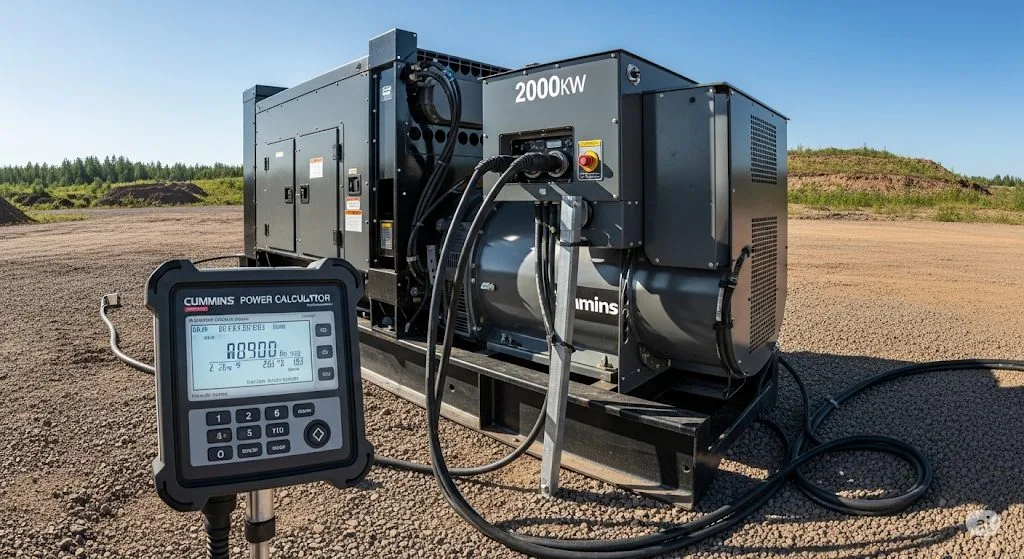Sell Your Generator
Schedule Service
Generator Rental Request Form
Power Calculators
The following power calculators are provided to help you determine the size of generator required for your specific application. Other calculators on this page are for unit conversions and other power related calculations.
Standard Electrical Formulas Used for Power Consumption Calculations
| TO DETERMINE: | SINGLE-PHASE | THREE-PHASE | DIRECT CURRENT |
|---|---|---|---|
| KVA | I x E / 1000 | I x E x 1.73 / 1000 | — |
| Kilowatts | I x E x PF / 1000 | I x E x 1.73 x PF / 1000 | I x E / 1000 |
| Horsepower | I x E x %EFF x PF / 746 | I x E x 1.732 x %EFF x PF / 746 | I x E x %EFF / 746 |
| Amperes (when HP is known) | HP x 746 / (E x %EFF x PF) | HP x 746 / (1.73 x E x %EFF x PF) | HP x 746 / (E x %EFF) |
| Amperes (when kW is known) | KW x 1000 / (E x PF) | KW x 1000 / (1.73 x E x PF) | KW x 1000 / E |
| Amperes (when KVA is known) | KVA x 1000 / E | KVA x 1000 / (1.73 x E) | — |
* LEGAL DISCLAIMER: Whenever complex electrical calculations are involved, it is always wise to seek the assistance of a certified electrician. The calculators on this page are offered to assist in generating general estimations only. In most instances, there are numerous additional factors that should be accounted for (such as altitude, site conditions, iron losses, motor efficiencies, etc.). If you are still unsure or would like assistance analyzing your current situation, feel free to contact us with your questions.
Commercial Generator Sizing Calculator
No matter your industry—whether it’s oil and gas, hospitality, or telecommunications—your facilities need to operate around the clock. To make that happen, you rely on generators to keep things running during scheduled or unexpected power outages. However, if your generators can’t meet your power demands, they won’t be able to support your facility. That’s why it’s critical to ensure your generators meet your load requirements and have extra capacity for reliability.
A commercial generator sizing calculator helps you quickly convert units and calculate power demands with precision.

How to Calculate What Size Generator You Need
Before using a power requirement calculator for generators, start by gathering some key data. Answer these questions to ensure accurate calculations:
- What items will the generator power?
Make a complete list of everything that will run on the generator. Missing even a few items could lead to under-sizing, which can result in power shortages. Collaborate with your team to ensure all equipment is accounted for. - What is the starting and running wattage of those items?
Check owner’s manuals for wattage details. If manuals aren’t available, look up the model number online or check the equipment’s identification plate. You can also use a power consumption chart, but keep in mind that these charts only offer estimates. When in doubt, contacting the manufacturer for exact wattage details is the best option. - What is the total power requirement for these items?
Once you have the power requirements, total them up using kilowatts (kW), which is the standard unit for commercial generators. If your equipment lists power usage in amperes, be sure to convert it to watts for consistency.
For more information on determining generator size, read: Sizing a Generator – How to Determine What Size You Need
How to Calculate Your Total Power Requirements
There are several ways to determine your total power needs. Some companies use multiple methods to cross-check their numbers and ensure accuracy. Click here for examples of how wattage usage varies between electrical devices. Here are three common approaches:
1. Measure Peak Usage in Real-Time
Use a clamp-on ammeter to measure the total amperage your facility uses during peak demand. This is important because your generator needs to handle the highest power requirements, not just average usage. Be sure to take measurements across all electrical service sections and add them together.
2. Review Your Monthly Power Bills
Utility bills often include peak demand information. Review past statements and note the highest peak demand over the last year. Then, add 25% extra capacity to account for unexpected surges or future expansions.
3. Calculate Power Based on Facility Size
For businesses like restaurants or hotels, estimating power needs based on square footage can be useful. A general rule of thumb:
- Add 5 watts per square foot, plus 50 kW
- For retail businesses, use 10 watts per square foot instead of 5
After gathering your equipment list and power requirements, consider key variables that can affect your generator sizing calculations.
Important Variables to Consider
Even with an accurate power calculation, external factors can impact generator performance. Keep these considerations in mind:
- Voltage Dips: When motors restart after a power outage, they draw extra current, causing voltage dips. If voltage dips exceed 15%, equipment damage and generator failure may occur. Make sure your generator has enough surge capability.
- Single-Phase vs. Three-Phase Power:
- Single-phase generators work well for small businesses and light applications.
- Three-phase generators are essential for industrial facilities that need continuous power for heavy loads.
- National Electrical Code (NEC) Compliance: If your facility has safety systems, ensure they’re included in your power calculations. NEC standards may also require additional reserve power capacity.
How to Use a Power Calculator for Generators
Our power calculator for generators helps you:
- Convert kVA to kW
- Convert kW to kVA
- Convert kW to horsepower (HP)
- Calculate amperes
- Determine kVA requirements for a three-phase power setup
Once you’ve converted any necessary values, enter your data into the commercial generator sizing calculator by selecting:
- Single- or three-phase power
- Required volts
- Amperes
- Power factor
The calculator will generate the total kW needed to keep your operations running during outages, ensuring you select the right generator for your facility.
Still have questions or looking for more information?
Generator Source specializes in low-hour, used, new, and surplus generator sets. We have a wide variety of generator sizes and models to fit any project. We are not a broker, we own what we sell.
Call us today (877-866-6895) or click Contact Us to be connected with one of our experienced sales reps.
We have 350+ generators in stock and ready to ship!
